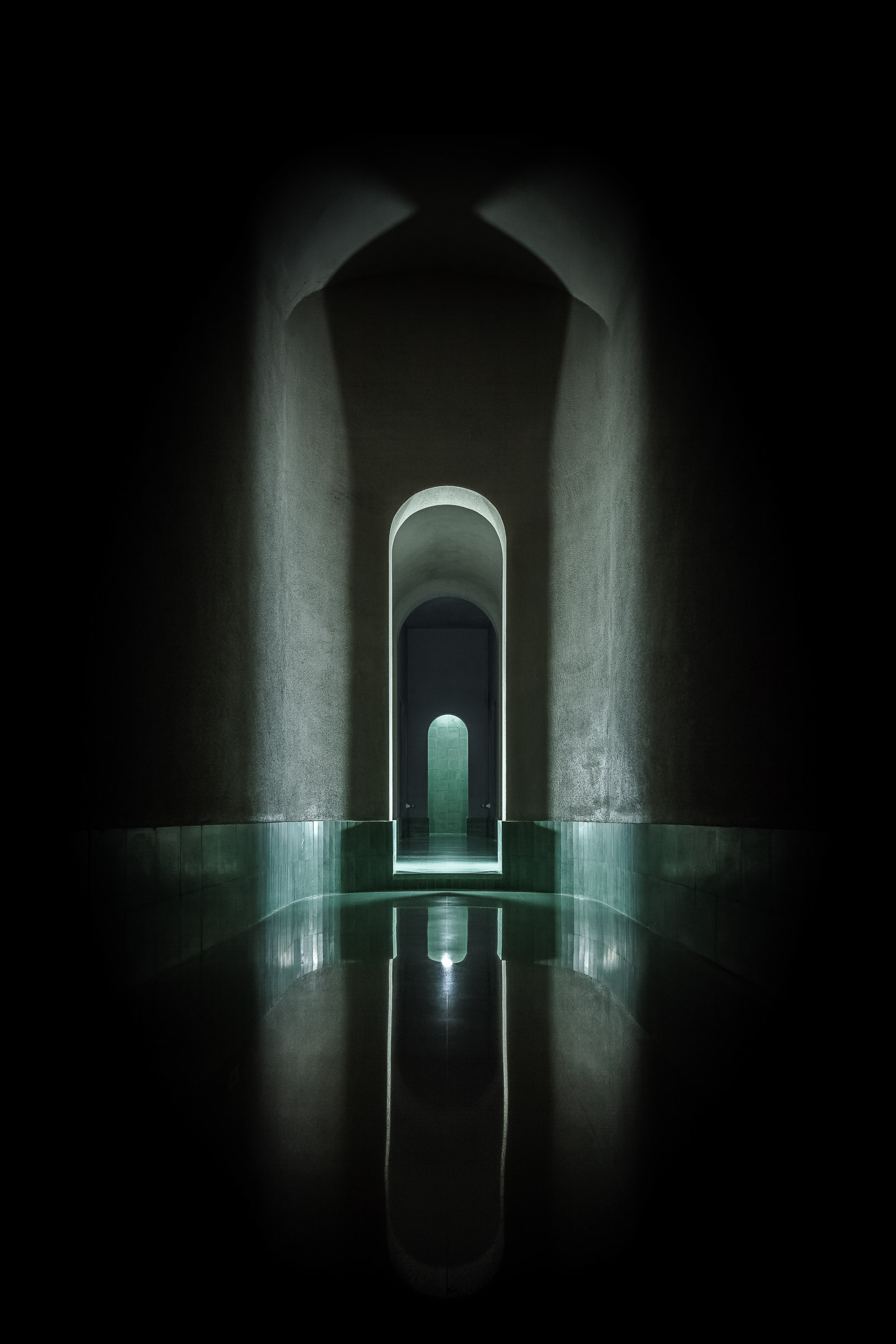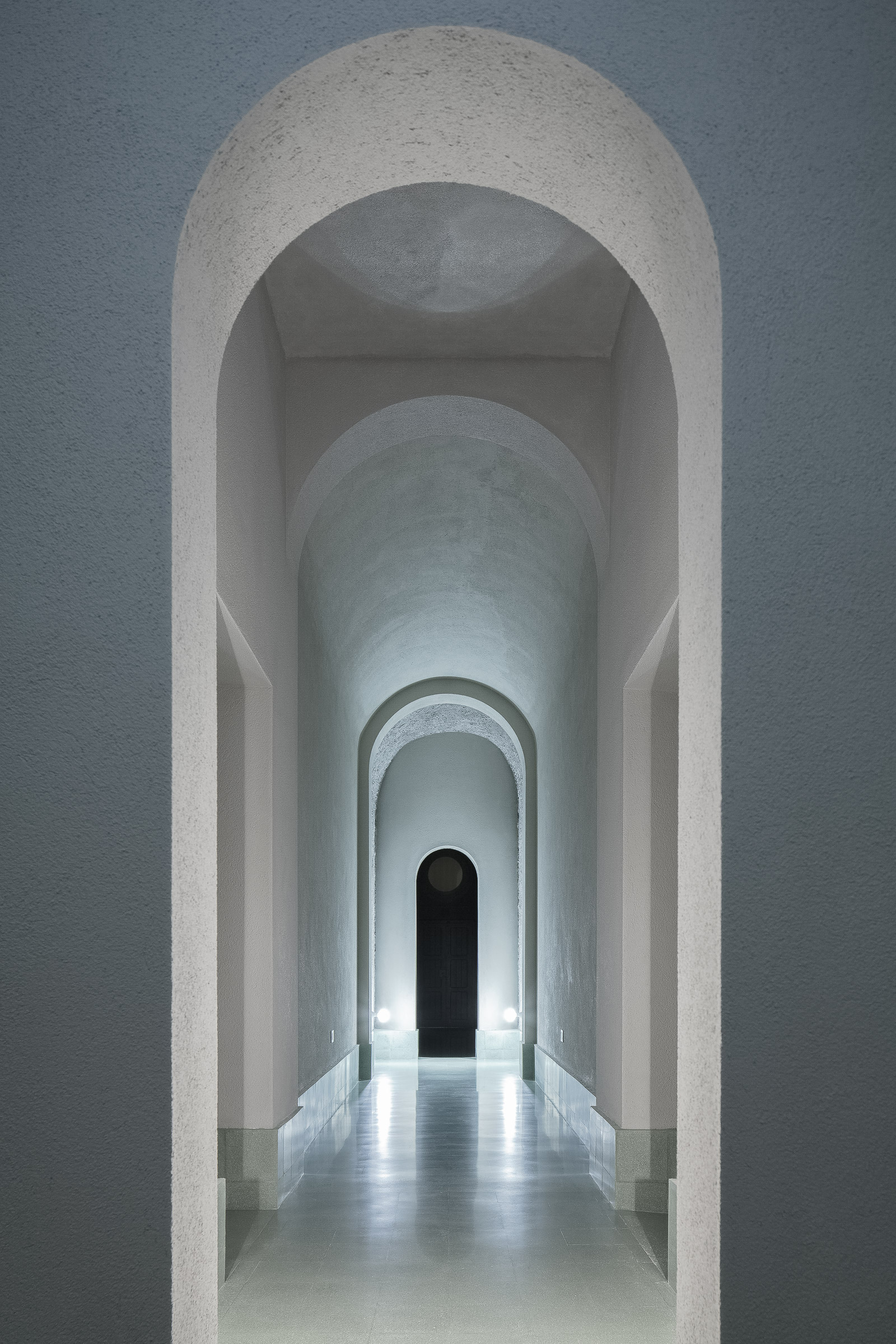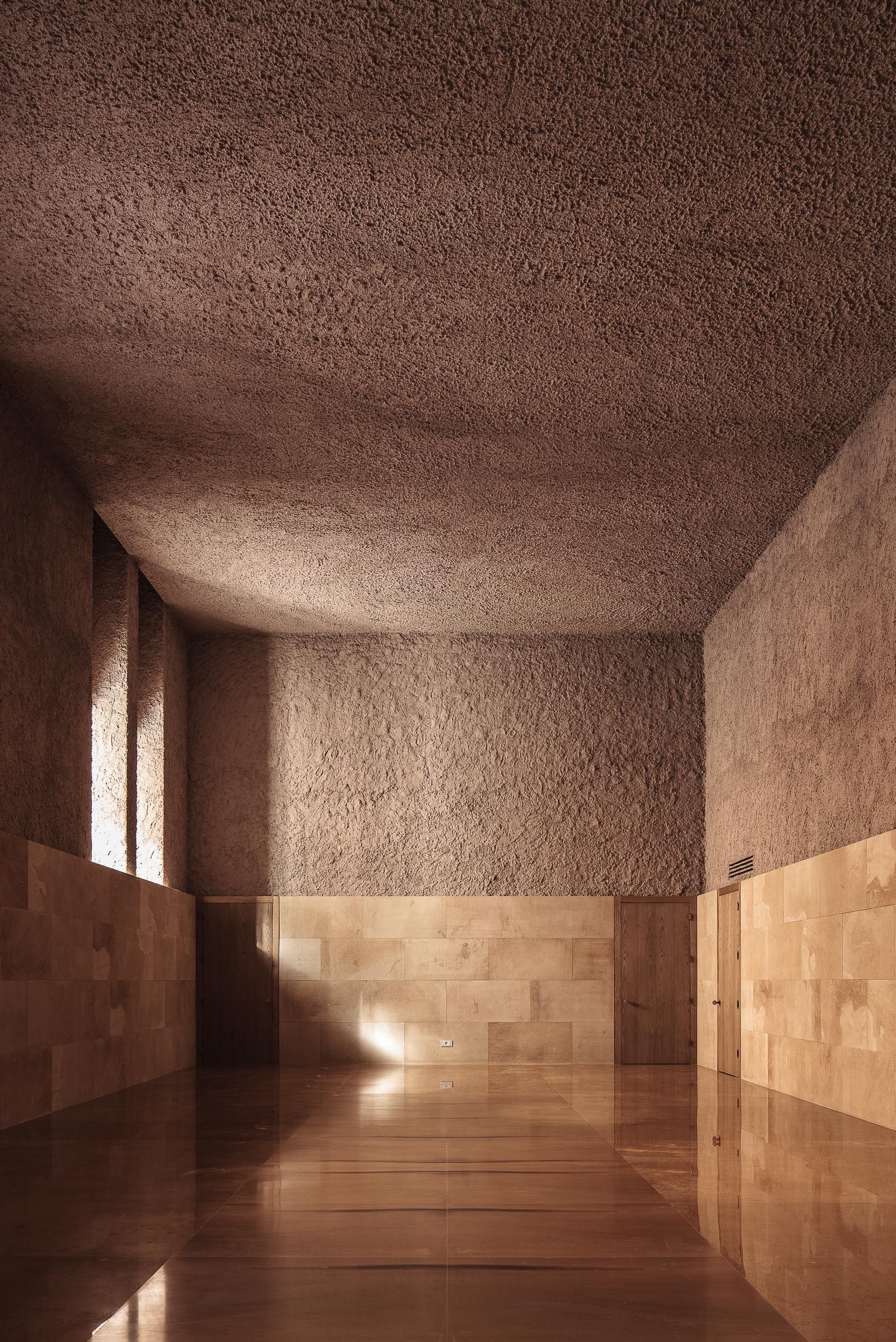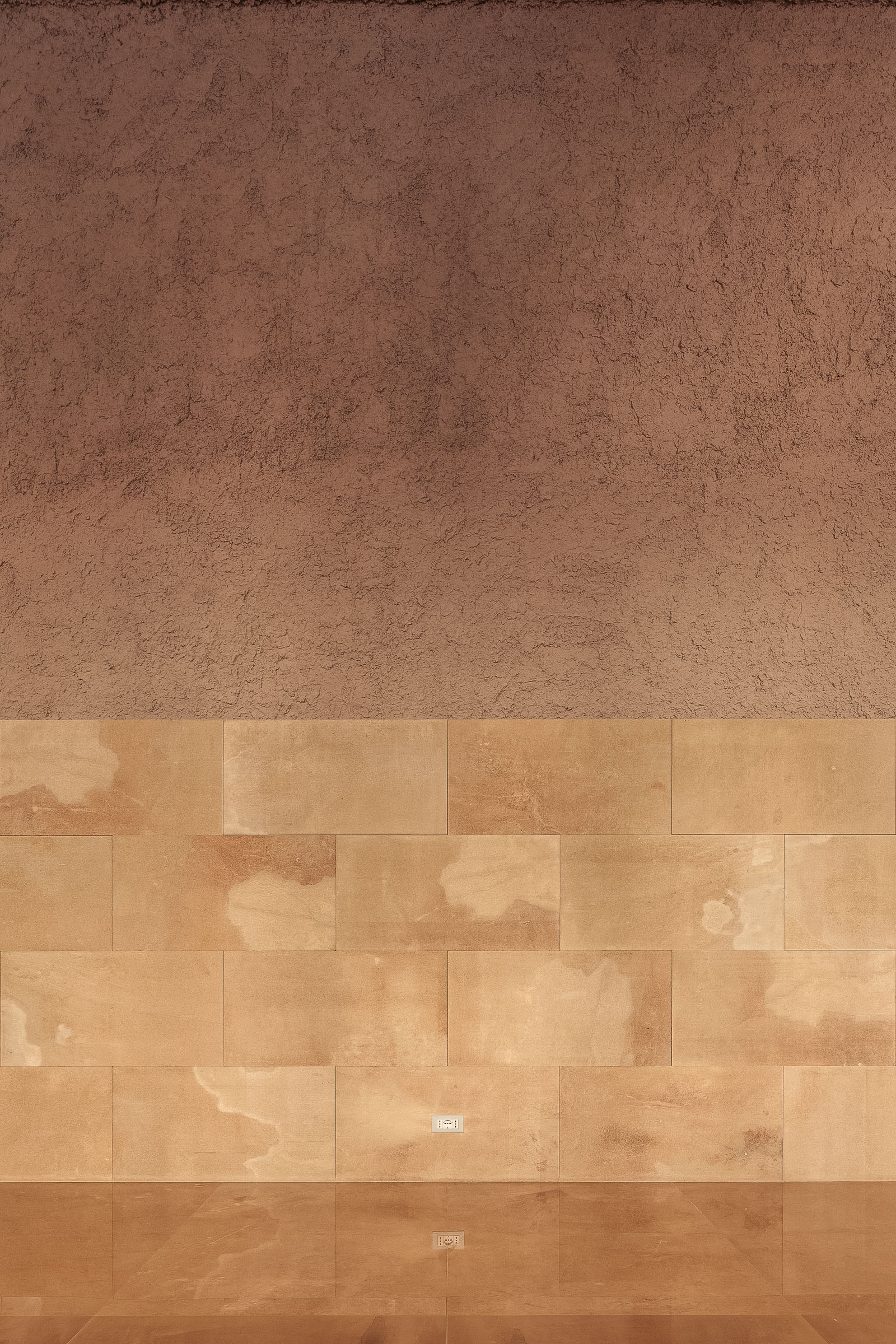Data
- Time: Design (Jan – Aug 2015); Text drafting (Dec 2015); Construction (Jan – Aug 2016); Photography (Aug 2016)
- Place: Sala Laurentina, Via Domenico Giglio, 12, Trapani, Italy
- Area: 260 m² (single storey)
- Typology: Oratory
Sala Laurentina, Cattedrale di San Lorenzo Martire, Trapani,
The Coral Cave is an oratory project in Trapani Cathedral’s Sala Laurentina. The project reclaims a sacred urban dimension through a design that juxtaposes golden and silver proportions with the symbolisms of an underwater cave with shells and corals, and a greenish gallery of elongated arches, evoking a labyrinth of memory and pre-modern imagination
Antonino Cardillo
We live away from all neighbours on a land’s end, with the sea roaring on either side of us, and no one can hurt us.
— Samuel Butler, Authoress of the Odyssey (1897)
The Coral Cave is a refuge from the world. A grotto where love can still happen. The place where the city regains its sacral dimension that binds those who were to those who are.
The Coral Cave explores a pre-modern idea: when architecture was imagination and the city was the labyrinth of memory. That labyrinth renewed every day with the caresses of our eyes; that speaks to us, mutedly, of lives lived. The image is the place where the dead speak to the living. Where it confirms the idea of life as permanence and tradition.
Without this silent dialogue, the city dies; entertainment and alienation take over neutralizing the subversive potential of love.
The Coral Cave speaks of the sacred that comes from the sea. The cadence of space recounts the allegories of beauty and metamorphosis imaged from shells evoked by the sediments of the stone base, and corals, to whose willowy asperities alludes the pink perpendicular vault.
Shells and corals populate the imagery of the town of Trapani. The story of the arrival of the Madonna from the sea and the carved stones of her sanctuary reveal how, along with the tradition of corals, the theme of the shell is a fundamental myth of the sacredness of the city.
The colour and tactile surfaces of the Specus rediscover the sensuality of the stone and dust that speak of the place and the bowels of the earth where they were carved. Thus Specus Corallii, with its evocation of a mysterious underwater dimension, relates that imaginary which, from the sea, has sedimented for millennia the sense of the life of the city and its landscape.
The Coral Cave looks like an antique oratory. The classic configuration of its architecture, a rectangle governed by the ‘silver ratio’, makes it available for different uses and interpretations; preventing the dominance of function and technology, always casual and transitory pretexts for architecture, from bringing about the obsolescence of the work.
Specus Corallii, Cattedrale di Trapani, Oct. 2016, pp. 11‑12.
Antonino Cardillo





2024 – 2016
Paolo Portoghesi
Portoghesi leafs slowly through the book and lingers over the image of a gallery with arches: ‘It looks as though it were carved into the page’.
L’Arca International, Monaco, 5 May 2024 (en, fr, it)
Karin Van Opstal
Whether he is working on his imaginary concepts or his tangible projects, Cardillo’s unique, archetypical work synthesises centuries of civilisation and makes eager use of historic building elements. […] His monumental, almost sacred rooms—a cave, a labyrinth or an oratory—breathe an aura of mysticism.
Villas, no. 107, Brussels, 6 September 2021, p. 70 (en, fr, nl)
Eva Gründel, Heinz Tomek
Besides famous ancient temples, Norman cathedrals, and Baroque palaces, they discovered modern architectural marvels [in Sicily], such as Antonino Cardillo’s Specus Corallii in Trapani […]
Sizilien, DuMont Reiseverlag, Ostfildern, 5 September 2019, media release (de, en, it)
Evdoxia Karageorg, Konstantina Vasileiadou
We cannot decide whether Specus Corallii looks more like emerging from the depths of the ocean or whether it is the image of the ocean itself which on the distant horizon coincides with the sky as if they are reaching their love-making peak.
Architecture and Eroticism. An Imaginary Wandering, Aristotle University of Thessaloniki, June 2019, pp. 80‑117 (el, en)
Akshaya Muralikumar
The coral tones of the spaces speak not just of the material but its relationship with the past of the city of Trapani. Space brings along, the reference of the sea with the coral shades and shell textures where the history will live on as indirect depictions. The coral caves have a lot of stories echoing.
re-thinkingthefuture.com, New Delhi, 10 August 2019 (en)
Brianna Ruland
This space evokes love and loss, nostalgia, melancholy, and life’s most essential inaudible philosophies. Most importantly, this long dark cave can certainly be trusted.
[email], ed. Matt Edwards, San Luis Obispo, 29 March 2018 (en, it)
Jean-Marie Martin
The spaces he has designed make clear the endless distance that separates them from what they evoke—while the measurement of distance is the most proper meaning of the evocation.
Casabella, no. 879, dir. Francesco Dal Co, Milan, November 2017, p. 30 (en, it, jp)
Mrinalini Ghadiok
The bold stroke of a fine brush on a plastered canvas defines the apical arch, repeated in tandem to create relentless perspectives and interminable depths.
Mondo* Arc India, no. 15, New Delhi, July 2017, p. 51 (en)
Francesca Gottardo
The wooden inlay in the oratory floor, […] represents the final destination in the journey and expresses the peaceful stability of a safe haven.
Abitare la terra, no. 41, dir. Paolo Portoghesi, Rome, May 2017, p. 46 (en, it)
Andreas Kühnlein
Antonino Cardillo has dedicated himself to a form of architecture with centuries-old tradition: the artificial grotto, which he translates into contemporary forms. Manifestations of his poetic spaces exist in London and Rome. The latest was created in Sicily.
AD Germany, no. 178, Munich, April 2017, p. 163 (de, en, it)
Luigi Frudà, Sebastiano Costantino
Trapani has recently earned a new pearl for its historic centre. In 2016 the work of restoration and total architectural re-design of a very old and historic building located in Via Generale Domenico Giglio, 12, a stone’s throw from the Cathedral of S. Lorenzo Martire.
Strenna d’agosto 2016, vol. 1, La Ragnatela, Rome, March 2017, pp. 305‑307 (it)
Jeanette Kunsmann
Antonino Cardillo masters the art of telling stories through spaces and materials: Visitors disappear into a mysterious passage that conjures up hidden underwater worlds. At the same time, these are familiar images and known forms. The world remains a labyrinth of memories, the architect is a time traveller—and architecture becomes ecstasy.
designlines.de, BauNetz, Berlin, 29 November 2016 (de, en, it)
Mariza D’Anna
At the back, a niche like a mihrab: ‘in the idea of architecture as a sacred and universal dimension’.
La Sicilia, Catania, 28 October 2016, p. 13 (en, it)
Jessica Mairs
Italian architect Antonino Cardillo has coated the walls of a vaulted chamber-music and events space in lumpy coral-pink, grey and green plasterwork.
dezeen.com, London, 26 October 2016 (en)
Peppe Occhipinti
The roughness of pozzolana, used for millennia as a coating, cancels, with its chiaroscuro effects due to the particular technique of roughcast application, the separation of the joining angles between the roof and the walls, evoking the airy quality of a vault that the sacred place must have once possessed.
[email], Trapani, 24 October 2016 (en, it)
2025 – 2019
C.G. Jung-Institut, Zurich,
Antonino Cardillo will present the seminar ‘Depth Architecture—The Aesthetic Nature of the Psyche’ as part of the autumn 2025 Analytical Psychology Training Program at the Carl Gustav Jung Institute of Zurich.
Museo Pepoli, Trapani,
Following an introduction by anthropologist Rita Cedrini, Antonino Cardillo presents his built works in the lecture ‘An integrative journey’, part of the conference Anthropology in Architecture at the Museo Agostino Pepoli in Trapani.
DIA, Bauhaus Campus, Dessau,
After an introduction by Professor Johannes Kister, Cardillo interprets seven images of his architectural works during the lecture ‘A synchronicity of cultures and civilisations’, part of the Dessau Talks series at the Dessau Institute of Architecture, Bauhaus Campus.
2025 – 2015 (selected)